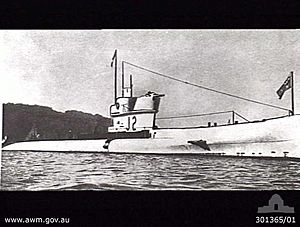HMS J2 facts for kids
class="infobox " style="float: right; clear: right; width: 315px; border-spacing: 2px; text-align: left; font-size: 90%;"
| colspan="2" style="text-align: center; font-size: 90%; line-height: 1.5em;" | 
|} HMS J2 (which later became HMAS J2) was a cool J-class submarine. It was used by two navies: first the Royal Navy (from the UK) and then the Royal Australian Navy (from Australia).
Contents
- What Made the J-Class Submarines Special?
- How J2 Moved Through Water
- Weapons and Crew on Board
- When and Where J2 Was Built
| History | |
|---|---|
| Name | HMS J2 |
| Builder | HM Dockyard, Portsmouth |
| Launched | 6 November 1915 |
| Fate | Transferred to Australia, 25 March 1919 |
| Name | HMAS J2 |
| Acquired | 25 March 1919 |
| Decommissioned | 12 July 1922 |
| Fate | Sunk 1 June 1926 |
| General characteristics | |
| Class and type | British J-class submarine |
| Displacement |
|
| Length | 275 ft (84 m) |
| Beam | 22 ft (6.7 m) |
| Draught | 14 ft (4.3 m) |
| Propulsion |
|
| Speed |
|
| Range | 4,000 nmi (7,400 km; 4,600 mi) at 12 kn (22 km/h; 14 mph) |
| Test depth | 300 ft (91 m) max |
| Complement | 44 personnel |
| Armament |
|
Designing and Building the J2 Submarine
What Made the J-Class Submarines Special?
The Royal Navy designed the J-class submarines because they heard that German submarines were very fast. These new British submarines were built to be even faster!
When floating on the surface, they weighed about 1,210 tons. When diving underwater, they weighed more, around 1,820 tons. Each submarine was about 275 feet (84 m) long, 22 feet (6.7 m) wide, and 14 feet (4.3 m) deep.
How J2 Moved Through Water
The J-class submarines were unique because they had three propellers. No other British submarines before or since have had three!
- When on the surface, three powerful 12-cylinder diesel engines pushed them along.
- When underwater, they used electric motors powered by batteries.
These submarines were super fast for their time. They could go up to 19 knots (35 km/h; 22 mph) (about 22 mph) on the surface. This made them the fastest submarines in the world when they were built! Underwater, they could still reach 9.5 knots (17.6 km/h; 10.9 mph) (about 11 mph). They could travel about 4,000 nautical miles (7,400 km; 4,600 mi) (about 4,600 miles) at a speed of 12 knots (22 km/h; 14 mph).
Weapons and Crew on Board
The J2 had six torpedo tubes that fired 18-inch torpedoes. Four of these tubes were at the front (bow), and one was on each side.
It also had a 4-inch gun on its deck. This gun was first placed near the conning tower (the part that sticks up), but later it was moved to the very front of the conning tower for better streamlining. A crew of 44 people worked on the submarine.
When and Where J2 Was Built
J2 was built for the Royal Navy at HM Dockyard in Portsmouth, England. It was officially launched into the water on 6 November 1915.
J2's Time in Service
Fighting in World War I
J2 had an important moment during World War I. On 7 July 1917, it successfully fired a torpedo and sank the German submarine U-99. This happened between the Orkney Islands and Norway.
Gift to Australia After the War
After World War I ended, the British Navy decided that submarines and cruisers would be the best way to protect the Pacific Ocean region. So, they gave six J-class submarines, including J2, to the Royal Australian Navy as gifts!
J2 and its sister submarines officially joined the Australian Navy in April 1919. They began their long journey to Australia on 9 April. They traveled with two cruisers, Sydney and Brisbane, and a support ship called Platypus.
The group of ships arrived at Thursday Island in Australia on 29 June and then reached Sydney on 10 July. Because the submarines were quite worn out from the long trip, they were immediately taken out of service for repairs and upgrades.
The submarines didn't see much action in Australia. They mostly did local training exercises. In 1921, they made a visit to Tasmania.
By June 1922, it became very expensive to keep the submarines running. Also, the economy wasn't doing well. Because of these reasons, all six submarines were taken out of service and planned to be sold.
The Final Resting Place of J2
J2 was officially taken out of service on 12 July 1922. It was then sold on 26 February 1924.
Finally, on 1 June 1926, J2 was purposely sunk (scuttled) in a special area called a ship graveyard. This spot is off the coast of Port Phillip Heads in Australia, at coordinates 38°18′49″S 144°34′48″E / 38.31361°S 144.58000°E.
Exploring the J2 Wreck Today
The wreck of J2 is also known by divers as "39 Metre Sub," "130 Foot Sub," "Broken Sub," or "Deep Sub." It lies underwater at a depth of 39 metres (128 ft) (about 128 feet).
The submarine rests upright on its bottom, pointing north–south with its front facing out to sea. When it was sunk, the front part of the submarine broke off. This means you can now see the torpedo tubes and other parts of the bow that were once hidden.
Only experienced divers should try to visit the J2 wreck. It is the deepest and most challenging of the four J-class submarine wrecks in that area.

